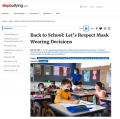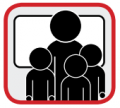Numerous studies have confirmed that elements of a positive school climate reduce bullying behaviors, and lessen negative outcomes for students who have been bullied. For example, more positive (trusting, responsive, and affirming) teacher-student relations lower aggressive behaviors including bullying. For students who have been bullied, maintaining engagement in school mitigates potential negative effects on the victim’s academic achievement and social interaction. Schools that provide a safe learning environment where staff model positive behavior they can mitigate the negative effects of bullying. Positive student-teacher relationships promoted lower levels of student aggression.
Though virtually all states now have laws concerning school bullying, these laws vary significantly in their provisions. The most commonly covered components in legislation are requirements to develop district policies, statements of scope defining school jurisdiction over bullying acts, definitions of prohibited behavior, and disciplinary consequences. Procedural components in laws (e.g., how bullying incidents are to be identified, reported, investigated, and resolved) are more likely to involve direct mandates, whereas programmatic components (e.g., training and prevention) are often prescribed using discretionary language. A major difference in state laws is the degree to which they specify policy content required of local districts, and some states simply require district policy without specifying content at all.
Stopbullying.gov provides a database on State and local policies across the country. Stay updated on the latest news in policies in your area by accessing the Laws & Policies page.
Recent data focusing on school-age youths ages 12–18 asks students if they had been bullied at school at any time during the past school year (Robers, et al., 2010). Twenty-one percent of those surveyed reported that they had been made fun of by their peers, 18 percent had been the subject of rumors, 11 percent had been pushed, shoved, tripped, or spit on, and 6 percent had been threatened with harm. These findings are comparable to other nationally representative surveys of high school-age students, which indicate that over a 12-month period as many as 20 percent of students experience bullying on school property (CDC, 2010). Similarly, for the 2009-2010 school year, another study found that 23 percent of schools reported that bullying behavior occurred on their schools campuses on a daily or weekly basis (Nieman, 2011). A large national survey of teachers and other school support staff found that 43 percent of school personnel consider bullying to be moderate or major problem for their schools and 41 percent reported witnessing bullying interactions at school once a week or more (Bradshaw, et, al., in press).
Reducing bullying behavior in schools requires a multi-faceted approach, including prevention, immediate response, and appropriate consequences and support for serious incidents. Bullying occurs along a continuum that ranges from occasional mean behavior to a - ”single interaction falls on this continuum, and many students, particularly in the middle school years, engage in these behaviors at some point. Nonetheless, all of these interactions can be hurtful and harm both individual youth and their learning environment. The current spate of state legislation addressing bullying in schools tends to emphasize the definition of bullying behavior that requires reporting, investigation, and consequences for the student who bullies. Many laws recommend that schools undertake prevention programs, but provide little support (e.g., these recommendations are universally unfunded).
Recognizing the importance of comprehensive prevention to address the broad lower range of the bullying continuum is important to managing the bullying problem (Bazelon, 2013). It is also important to provide guidance to teachers and school employees concerning intervention in behaviors at the lower end of this continuum. As the noted bullying researcher Dan Olweus noted (1997) “if it's mean, intervene” (Oweus, 1997). Providing a range of school responses gauged to particular behaviors will keep a manageable problem driven by many contextual and child development issues into an overwhelming disciplinary problem (Bazelon, 2013).
Bazelon, E. (2013). Sticks and Stones: Defeating the culture of bullying and rediscovering the power of character and empathy. New York: Random House
Bradshaw, C.P., Wassdorp, E., O’Brennan, T., Linday, and Gulemetova, M. (2011). Findings for the National Education Association’s Nationwide Study of Bullying: Teachers’ and Education Support Professionals’ Perspectives. National Education Association.
Centers for Disease Control and Prevention. (2010). YRBSS 2009 National Youth Risk Behavior Surveillance Overview. U.S. Department of Health and Human Services. Accessed March 2011. http://www.cdc.gov/HealthyYouth/yrbs/index.htm.
Henry, D. B., Farrell, A. D., Schoeny, M. E., Tolan, P. H., & Dymnicki, A. B. (2011). Influence of school-level variables on aggression and associated attitudes of middle school students. Journal of School Psychology, 49, 481–503. doi:10.1016/j.jsp.2011.04.007.
Neiman, S. (2011). Crime, Violence, Discipline, and Safety in U.S. Public Schools: Findings From the School Survey on Crime and Safety: 2009–10 (NCES 2011-320). U.S. Department of Education, National Center for Education Statistics. Washington, DC: U.S. Department of Education.
Olweus, D. (1997). Bully/victim problems in school: facts and intervention, European Journal of Psychology of Education 12: 495-510.
Robers, S., Zhang, J. and Truman, J. (2010). Indicators of School Crime and Safety: 2010 (NCES 2011-002/ NCJ 230812). National Center for Education Statistics, U.S. Department of Education, and Bureau of Justice Statistics, Office of Justice Programs, U.S. Department of Justice. Washington, DC.
Seeley, K., Tombari, M. L., Bennett, L.J., & Dunkle, J.B. (2011) Bullying in schools: an overview. Office of Juvenile Justice and Delinquency Prevention. Juvenile Justice Bulletin.
U.S. Department of Education, Office of Planning, Evaluation and Policy Development, Policy and Program Studies Service, Analysis of State Bullying Laws and Policies, Washington, D.C. 2011.
Konishi, C., Miyazaki, Y., Hymel, S., & Waterhouse, T. (2017). Investigating associations between school climate and bullying in secondary schools: Multilevel contextual effects modeling. School Psychology International, 38(3), 240-263.
Fossum, S., Skokauskas, N., Handegård, B. H., Hansen, K. L., & Kyrrestad, H. (2021). The Significance of Traditional Bullying, Cyberbullying, and Mental Health Problems for Middle School Students Feeling Unsafe in the School Environment. Scandinavian Journal of Educational Research, 1-13.
Model State Anti-Bullying & Harassment Legislation. GLSEN. (2020). Available at https://www.glsen.org/activity/model-state-anti-bullying-harassment-legislation


